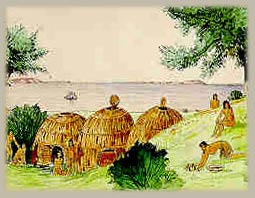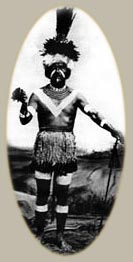 |
 The
Chumash Indians were not like the Indians we know from the Western novels
or movies. These people belonged to a very old tribe. They lived all
around California's central coast. They were once the largest cultural
group among western tribes. Before the mission period the Chumash lived
in 150 independent villages with a total population of about 20,000
people, but they were greatly reduced when the Spanish, Mexican and
American missionaries insisted they become Christians. So soldiers were
sent out to the Chumash villages to bring the Chumash by force if necessary
into the mission. Families were broken up, men and women forced to live
separately. They died by thousands in epidemics of smallpox and malaria.
California's Indian population dropped from approximately 310,000 in
1769 to 30,000 by the end of the gold rush in 1860. The
Chumash Indians were not like the Indians we know from the Western novels
or movies. These people belonged to a very old tribe. They lived all
around California's central coast. They were once the largest cultural
group among western tribes. Before the mission period the Chumash lived
in 150 independent villages with a total population of about 20,000
people, but they were greatly reduced when the Spanish, Mexican and
American missionaries insisted they become Christians. So soldiers were
sent out to the Chumash villages to bring the Chumash by force if necessary
into the mission. Families were broken up, men and women forced to live
separately. They died by thousands in epidemics of smallpox and malaria.
California's Indian population dropped from approximately 310,000 in
1769 to 30,000 by the end of the gold rush in 1860.
Today only the Samala subdivision of the Chumash are legally recognized by the federal government of the United States. |
|
|
|
GUESTBOOK |
|
by The JavaScript Source
Midi music "Fairy" by unknown Webdesign and Graphics by Black Hawk Designs © 2004
The Artwork is from the Book "The Chumash Indians" by Martin Schwabucher Photo "The Chumash ceremonial costume of a Shaman" by unknown |
 Each
Chumash family lived in a house called "An Áp", the houses
were usually 12 to 20 feet long. They were a very creative and
artistic people. The Chumash created some of the finest rock paintings
found throughout the chaparral region north of Los Angeles. They are
also known for their fine basketry made with the twining method and
for their money made from sea shells and their invention of the plank
canoe. The Chumash Indians didn´t were much clothing, the women usually
wore a two-piece skirt of deer skin or plant fiber. The men wore almost
nothing at all, but in the winter they sometimes wear capes of animal
skins for warmth.
Each
Chumash family lived in a house called "An Áp", the houses
were usually 12 to 20 feet long. They were a very creative and
artistic people. The Chumash created some of the finest rock paintings
found throughout the chaparral region north of Los Angeles. They are
also known for their fine basketry made with the twining method and
for their money made from sea shells and their invention of the plank
canoe. The Chumash Indians didn´t were much clothing, the women usually
wore a two-piece skirt of deer skin or plant fiber. The men wore almost
nothing at all, but in the winter they sometimes wear capes of animal
skins for warmth. 
 bravenet.com
bravenet.com